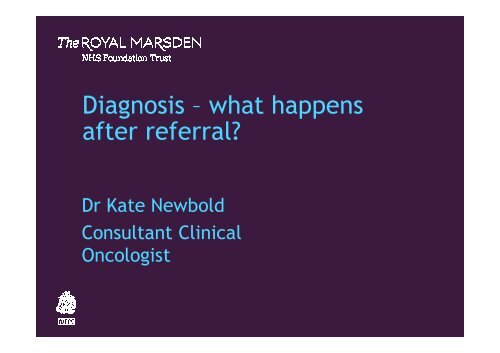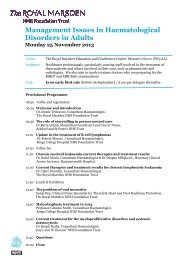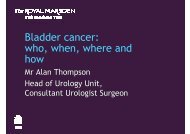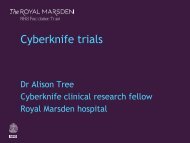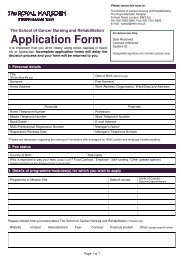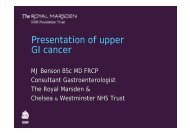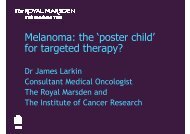Kate Newbold - Royal Marsden Hospital
Kate Newbold - Royal Marsden Hospital
Kate Newbold - Royal Marsden Hospital
- No tags were found...
You also want an ePaper? Increase the reach of your titles
YUMPU automatically turns print PDFs into web optimized ePapers that Google loves.
The <strong>Royal</strong> <strong>Marsden</strong>Diagnosis – what happensafter referral?Dr <strong>Kate</strong> <strong>Newbold</strong>Consultant ClinicalOncologist
The <strong>Royal</strong> <strong>Marsden</strong>Treatment Modalities• Early stage disease-larynx and naso/oro/hypopharynx: RT alone-oral cavity: surgery alone• Advanced stage naso/oro/hypophrynx andlarynx- organ preservation- radical chemoradiotherapy• Advanced stage oral cavity/paranasal sinuses-primary surgery-adjuvant (chemo)radiotherapy
The <strong>Royal</strong> <strong>Marsden</strong>Early Stage disease• Early Larynx-T1-2 N0 larynx-3.5 to 4 weeks of daily RT-16-20 fractions• Stage I-II naso/oro/hypopharynx- 6 weeks of daily RT alone- 30 fractions
The <strong>Royal</strong> <strong>Marsden</strong>Advanced Stage disease• Stage III larynx-Induction chemotherapy and chemoradiotherapy• Stage IV larynx-Laryngectomy• Stage III-IV naso/oro/hypopharynx-Induction chemotherapy and chemoradiotherapy
The <strong>Royal</strong> <strong>Marsden</strong>QuestionsWhat is the 2 year survival rate for stage I-II head andneck cancer ?A: 70%
The <strong>Royal</strong> <strong>Marsden</strong>QuestionsWhat is the 2 year survival rate for stage III-IV head andneck cancer ?A: 70%
The <strong>Royal</strong> <strong>Marsden</strong>2 year survival rates (CRUK)Table 3.1: Stage and two-year crude survival, cancers of the oralcavity and pharynx, South and West of England, 1996-2000Oral cavity 2-year crude Pharynx 2-year crudeNo. of cases survival (CI) No. of cases survival (CI)% %All cases 411 62.0 (57.3-66.7) 279 50.9 (45.0-56.8)I Early disease 21 87.5 (80.6-94.4) 6 77.8 (58.6-97.0)II Locally advanced 17 68.6 (57.6-79.6) 14 52.6 (36.7-68.5)III Tumour in lymphnodes 15 52.5 (40.0-65.0) 22 49.2 (36.7-61.7)IV Metastatic 36 46.0 (38.0-54.0) 48 46.6 (38.2-55.0)Unknown 11 68.2 (54.5-81.9) 10 55.2 (37.2-73.2)
The <strong>Royal</strong> <strong>Marsden</strong>Sequential induction chemotherapy followed byradical chemo-radiation in the treatment oflocoregionally advanced head and neck cancerBhide et al, BJC 2008LC 72% at 2 yearsOS 63% at 2 years
•2 year overallsurvival 86.7%•2 year PFS-Oral cavity 86%-Nasopharynx94%-Oropharynx84%-Pharyngolarynx83%Radiotherapy and Oncology EPUB ahead ofprint
The <strong>Royal</strong> <strong>Marsden</strong>Induction chemotherapy• Evidence for chemotherapy in addition toradiotherapy in patients ≤ 70 years• 2 x 21 day cycles of induction chemotherapy-Cisplatin and 5 Fluorouracil i.v.-5 days inpatient-SEs:myelosuppressionnausea and vomitingtinnitus/hearing lossnephrotoxicityfertility
The <strong>Royal</strong> <strong>Marsden</strong>Chemoradiotherapy– 6 weeks, 30 fractions– OP treatment, mon – fri– Concomitant cisplatin chemo Day 1 and 29 ofradiotherapy. Overnight stay
The <strong>Royal</strong> <strong>Marsden</strong>Preparation for chemoradiotherapy
The <strong>Royal</strong> <strong>Marsden</strong>QuestionWhy do we perform dental assessment before radicalradiotherapy?A: to make radiotherapy delivery easierB: to improve radiation dose homogeneityC: to reduce risk of osteoradionecrosisD: to reduce risk of infection
The <strong>Royal</strong> <strong>Marsden</strong>Preparation for Chemoradiotherapy (1)• Dental assessment-RT causes xerostomia-RT reduces vasculaity of mandible• Aim to prevent osteoradionecrosis• Require OPG and review by oral surgeon/restorativedentist• At least 14 days required between extractions andstart RT
The <strong>Royal</strong> <strong>Marsden</strong>QuestionWhich should patients stop during treatment?A: alcoholB: smokingC: dairy productsD: red meat
The <strong>Royal</strong> <strong>Marsden</strong>Preparation for Chemoradiotherapy (2)• Nutrition-dietetic review-risk of re-feeding syndrome-degree of poor/malnutrition• Alcohol-assess for risk of withdrawal• Smoking• -reduces rate of cure by 30%-increases treatment induced toxicty-offer cessation advice and help in conjunction withGP
The <strong>Royal</strong> <strong>Marsden</strong>Preparation for Chemoradiotherapy (3)• Renal function-EDTA or Cockcroft calculation-GFR >60ml/min proceed with cisplatin-GFR
The <strong>Royal</strong> <strong>Marsden</strong>Preparation for Chemoradiotherapy (4)• If cardiac pacemaker or implantable defibrillator- needs review by cardiac technologists-may need daily monitoring during treatment
The <strong>Royal</strong> <strong>Marsden</strong>Radiotherapy Planning
The <strong>Royal</strong> <strong>Marsden</strong>Mould Room
The <strong>Royal</strong> <strong>Marsden</strong>CT planning - 3D Reconstruction
The <strong>Royal</strong> <strong>Marsden</strong>Intensity-Modulated Radiotherapy(IMRT)Intensity-ModulatedRadiotherapy (IMRT)
The <strong>Royal</strong> <strong>Marsden</strong>What is Intensity Modulated Radiotherapy?TumourDoseConventionalRadiotherapyTissueIntensity ModulatedRadiotherapy
The <strong>Royal</strong> <strong>Marsden</strong>
The <strong>Royal</strong> <strong>Marsden</strong>Linear Accelerator
The <strong>Royal</strong> <strong>Marsden</strong>Toxicity of radiotherapy• normal tissue tolerance depends on– total volume irradiated– total dose– fractionation schedule ie size of each fraction,number of fractions, duration of treatment– previous surgery– co-existing problems eg smoking, drinking, chronicdisease
The <strong>Royal</strong> <strong>Marsden</strong>Toxicity of radiotherapyEarly-2-3 weeks into treatment-reversible - settle within 4 - 6 weeks of completion oftreatment-present to some degree in all patients-severity does not predict for late toxicityLate-6-9 months post RT-tends to be permanent, may be progressive-5-10% of patients will develop severe toxicity
The <strong>Royal</strong> <strong>Marsden</strong>Toxicity of radiotherapy – earlySkin– erythema– dry desquamation– moistdesquamation– hair loss
The <strong>Royal</strong> <strong>Marsden</strong>Toxicity of Radiotherapy- earlyMucous membranesloss of taste, dry mouth, dysphagia, mucositis
The <strong>Royal</strong> <strong>Marsden</strong>Loss of taste– Damage to the circumvallate and fungiform papillaeafter 20Gy– Bitter/sour affected more than sweet/salty– Partial/complete recovery is usual but recovery canbe slow
The <strong>Royal</strong> <strong>Marsden</strong>Xerostomia– Major salivary glands produce 90% saliva– Parotid gland often in irradiated volume– The serous acini are more sensitive than the mucousacini, resulting in production of thick saliva– Change in oral flora
The <strong>Royal</strong> <strong>Marsden</strong>Toxicity - late• Skin-alopecia-oedema / fibrosis-Depigmentation• Salivary glands-Xerostomia• Dental• Hearing-EAM-Middle ear-Cochlea• Spinal cord-Lhermittes synd-Myelitis
The <strong>Royal</strong> <strong>Marsden</strong>Osteoradionecrosis• Occurs in the mandible– Hypoxia andhypovascularity• Related to– Total dose– Dose/#– Brachytherapy– Chemotherapy?
The <strong>Royal</strong> <strong>Marsden</strong>QuestionDo breaks or gaps in radiotherapy:A: reduce overall survivalB: reduce local controlC: reduce acute toxicityD: reduce late toxicity
The <strong>Royal</strong> <strong>Marsden</strong>Importance of Overall Time of Treatment– Decreased tumour control probability (TCP) whensame dose is delivered over longer time– Need to deliver higher dose to maintain TCP iftreatment duration prolonged– Explained by rapid repopulation in response toclonogenic cell depletion during RT
The <strong>Royal</strong> <strong>Marsden</strong>K. Kian Ang, 2001: Interval between Surgeryand PORT
The <strong>Royal</strong> <strong>Marsden</strong>K. Kian Ang, 2001: Cumulative time ofcombined modality
The <strong>Royal</strong> <strong>Marsden</strong>ConclusionThe Challenge-advanced disease-function preservation, cosmesis-proximity of critical structures-compliance-nutrition
The <strong>Royal</strong> <strong>Marsden</strong>MDT– ENT– Maxillo-Facial– Plastics– Restorative Dentists– Clinical Oncologists– Palliative Care– Radiologists– Histopathologists– Cytopathologists– Psychologist/psychiatrist– SALT– Dietitians– Clinical Nurse Specialists– Research Nurses– Social Worker– Physicists– Radiographers– Prosthetics– Primary Care


